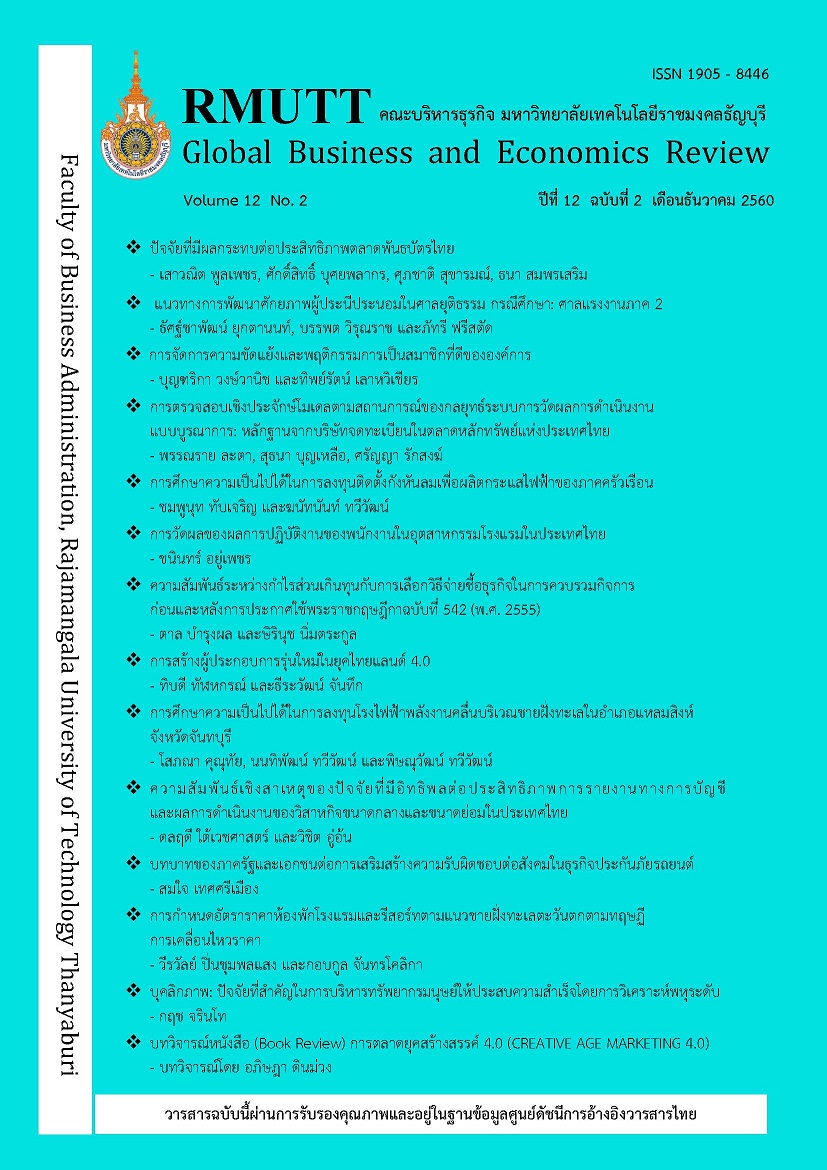A FEASIBILITY STUDY OF INVESTMENT ON ELECTRICITY POWER FROM WIND TURBINE OF HOUSEHOLD
Keywords:
A Feasibility Study, Wind Turbine, Electricity PowerAbstract
A Feasibility Study of Investment on Electricity Power from Wind Turbine of Household aims to (1) To determine the areas that are suitable for the installation of wind turbines to generate electricity in the household (2) To study the technical and alternative of investment to install wind turbines to generate electricity in the household (3) To study the feasibility of financial investment in installing wind turbines to generate electricity in the household sector (4) To study the purchase price model Feed-in Tariff (FiT) suitable for investment by the government to install wind turbines to generate electricity in the household sector. The study was conducted by collecting primary data from participant observation and in-depth interviews from 3 experts on wind turbines for electricity production. For secondary data, they have been collected from technical papers, related research and websites. Data were analyzed using descriptive and quantitative methods. Financial instruments being used include the followings: Net Present Value (NPV), Internal Rate of Return (IRR), Modified Internal Rate of Return (MIRR), Profitability Index (PI) and Switching Value Test (SVT). The study found that the southern and eastern sea coasts have the potential to produce electricity from wind. The technical study found that areas with a wind speed between 2 and 5 meter per second (m/s) should install wind turbine size 200 watts, areas with a wind speed between 5 and 7 m/s should install wind turbine size 500 watts and areas with a wind speed between 7 and 12 m/s should install wind turbine size 1000 watts. The feasibility study on investment project has the following assumptions: the project lasts 20 years, Weighted Average Cost of Capital (WACC) at 6.58% and Personal Income Tax rate at 0%. The case that was supported by the Government in Feed-in-Tariff rate at 6.06%. The study concluded that wind turbine size 200 Watts is not worth the investment. Despite wind turbine sizes 500 Watts and 1000 Watts, they are feasible for investment. For the case of no support by the Government in Feed-in-Tariff rate, the value of electrical energy equals to 4.4217 baht per unit, the variable rate equals 0.34 baht per unit and VAT rate is 7.00%. The study concluded that wind turbine size 200 Watts is not worth the investment, while wind turbine sizes 500 Watts and 1000 Watts are feasible for investment.
References
กรมพัฒนาพลังงานทดแทนและอนุรักษ์พลังงาน. (2559). สถานการณ์พลังงานของประเทศไทย 2558. สืบค้น จาก http://www.dede.go.th/ewt_news.php?nid=43397
กรมพัฒนาและส่งเสริมพลังงาน. (2559). แผนที่ศักยภาพพลังงานลมของประเทศไทย. สืบค้นจาก http://www2.dede.go.th/renew/Twm/main.htm
กระทรวงพลังงาน. (2559). นโยบายการรับซื้อไฟฟ้าจากพลังงานหมุนเวียนในรูปแบบ Feed-in-Tariff. สืบค้นจาก http://www2.eppo.go.th/power/fit-seminar/FiT_2558.pdf
กระทรวงพลังงาน. (2559). แผนพัฒนาพลังงานทดแทนและพลังงานทางเลือก พ.ศ. 2558-2579. สืบค้น จาก http://www.dede.go.th/download/files/AEDP2015_Final_version.pdf
การไฟฟ้าส่วนภูมิภาค. (2559). ผู้ผลิตไฟฟ้าขนาดเล็กมาก(VSPP). สืบค้นจาก https://www.pea.co.th/ เกี่ยวกับเรา/การดำเนินการตามนโยบายรัฐบาล/ผู้ผลิตไฟฟ้าขนาดเล็กมาก-VSPP/PID/1078/ evl/0/CategoryID/40/CategoryName/ผู้ผลิตไฟฟ้าขนาดเล็กมากVSPP
เนเชอรัล-เอ็นเนอจี้. (2559). ชุดกังหันลมผลิตไฟฟ้า. สืบค้นจาก http://www.naturalenergyth.com/ inhome.html
ประสิทธิ์ ตงยิ่งศิริ. (2544). การวางแผนและวิเคราะห์โครงการ. กรุงเทพฯ: ซีเอ็ดยูเคชั่น.
สงกรานต์ สังขรัตน์. (2558). ความเป็นไปได้ในการลงทุนระบบการผลิตไฟฟ้าด้วยพลังงานแสงอาทิตย์บนหลังคาบ้าน. (วิทยานิพนธ์ปริญญามหาบัณฑิต, มหาวิทยาลัยเกษตรศาสตร์).
สมาคมพลังงานทดแทนสู่ชุมชนแห่งประเทศไทย. (2558). ส่วนประกอบของกังหันลมเพื่อผลิตไฟฟ้า. สืบค้น จาก http://www.reca.or.th/library-wind-power.aspx
สำนักงานคณะกรรมการนโยบายพลังงานแห่งชาติ. (2558). แผนพัฒนากำลังผลิตไฟฟ้าของประเทศไทย พ.ศ. 2558-2579. สืบค้นจาก http://www.eepmekong.org/index.php/resources/ country-reports/thailand/217-thailand-power-development-plan-2015-2036-full- text-in-thai/file
สำนักงานนโยบายและแผนพลังงาน. (2558). ผู้ผลิตไฟฟ้าขนาดเล็กมาก (Very Small Power Producer VSPP). สืบค้นจาก http://www.eppo.go.th/images/Power/pdf/vspp- renew.pdf
หฤทัย มีนะพันธ์. (2550). หลักการวิเคราะห์โครงการ: ทฤษฎีและวิธีปฎิบัติเพื่อศึกษาความเป็นไปได้ของโครงการ. กรุงเทพฯ: แทกซ์ แอนด์ เจอร์นัล พับลิเคชั่น.
Downloads
Published
How to Cite
Issue
Section
License
บทความที่ได้รับการตีพิมพ์เป็นลิขสิทธิ์ของผู้นิพนธ์
ข้อความที่ปรากฏในบทความแต่ละเรื่องในวารสารวิชาการเล่มนี้เป็นความคิดเห็นส่วนตัวของผู้เขียนแต่ละท่านไม่เกี่ยวข้องกับมหาวิทยาลัยเทคโนโลยีราชมงคลธัญบุรี และคณาจารย์ท่านอื่นๆในมหาวิทยาลัยฯ แต่อย่างใด ความรับผิดชอบองค์ประกอบทั้งหมดของบทความแต่ละเรื่องเป็นของผู้เขียนแต่ละท่าน หากมีความผิดพลาดใดๆ ผู้เขียนแต่ละท่านจะรับผิดชอบบทความของตนเองแต่ผู้เดียว







